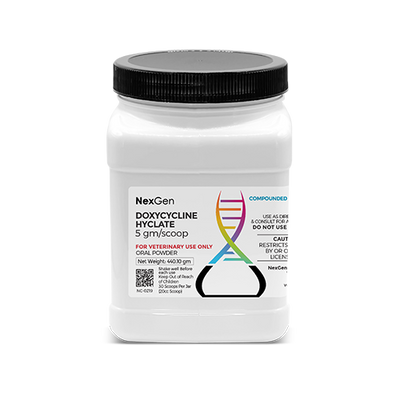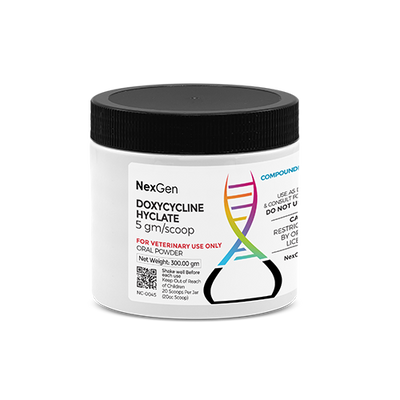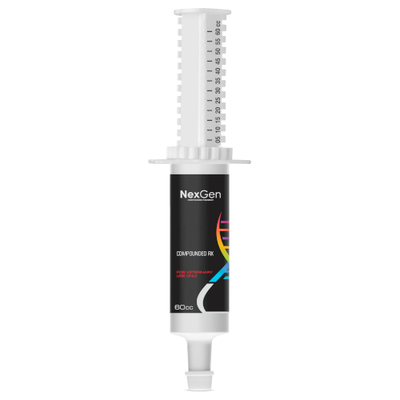
Doxycycline Hyclate 5 gm/15mL, Oral Paste, 60mL Syringe
Login for pricing
- Brand
- Mixlab
- SKU:
- NC-0217
- Product Type:
- Paste
- Size:
- 60ml
- Administration:
- Oral
In many cases, horses can break with bacterial diseases after their immune system has already been compromised by a virus. Bacterial infections are more common in horses that that travel or spend a lot of time at training stables where lots of different horses are coming and going. Foals and older horses are much more at risk of becoming sick because their immune systems are not as strong as adult horses in their prime.
Horses who are sick with a bacterial infection will often have digestive upset or an upper respiratory infection. Systemic bacterial infections typically cause a fever and lethargy, but there are other localized bacterial infections that can plague horses. Cleanliness practices in facilities where horses are kept or frequent are key to keeping bacteria from spreading.
Here, we’ll address some common but troublesome bacterial infections of horses that can often be treated similarly.
Strangles is an infectious disease characterized by abscessation of the lymphoid tissue in the upper respiratory tract. Streptococcus equi equi is the bacterium which causes the disease, and is transmitted via direct contact with infected horses or subclinical shedders, or indirectly via contact with equipment or nasal discharges from infected horses.
The bacterium Clostridium difficile is considered one of the most important causes of diarrhea and enterocolitis in horses. Foals and adult horses are equally susceptible to the infection. The highly resistant spore of C. difficile is the infectious unit of transmission, which occurs primarily via the fecal-oral route. Two major risk factors for the development of C. difficile-associated disease (CDAD) in adult horses are hospitalization and antimicrobial treatment, although sporadically, cases of CDAD can occur in horses that have not received antimicrobials or been hospitalized.1
Lyme disease is induced by the spirochete B. burgdorferi, with the spirochetes being transmitted to horses by infected ticks. Similar to humans, horses are incidental, dead-end hosts for B. burgdorferi. Not all infected horses will develop clinical signs of Lyme disease. If clinical signs occur, they can include chronic weight loss, sporadic lameness, shifting leg lameness, low-grade fever, muscle tenderness, chronically poor performance, swollen joints, arthritis and diverse orthopedic problems. Changes in behavior and skin sensitivity are common clinical signs seen by many practitioners in horses with potential Lyme disease. Neurological signs such as depression, dysphagia, head tilt and encephalitis have been reported in chronic cases.2
Skin infections can be bacterial or fungal, with mud fever or scratches being among the most common bacterial infections in the horse. Scratches, or pastern dermatitis, is caused by the bacteria Staphylococcus and/or Dermatophilus congolensis, and usually affects the back of the pastern extending down to the hoof. Draft horses, or any breed with feathered legs, are more commonly and more severely affected. Mud fever presents as small scabs on the back of the legs that often are slightly yellow in color.
Dermatophilus congolensis can also cause a skin infection commonly referred to as rain rot. Symptoms of rain rot usually start out as bumps under the coat, which becomes matted and develops characteristic “paintbrush” lesions on the back and neck. The skin becomes flaky and develops scabs similar to those described for mud fever.
Eye infections are also common in horses and can negatively impact training and quality of life. Some eye infections, such as those of the cornea, can be caused by bacteria or fungi. A common cause of eye infections includes Equine Recurrent Uveitis (ERU), a disease characterized by eye inflammation. The damage from this disease is progressive and can lead to scarring within the eye, cataracts, glaucoma, and even blindness. This disease has no cure, but it can be treated by reducing the amount of inflammation in the eye, as needed. Many eye infections also can be caused by hazards in the horse’s environment, such as excessive dust, sharp fence posts, or other obstacles. These can lead to opportunistic bacterial infections as well.
Where to buy Doxycycline
Doxycycline is available in the U.S. through several pharmaceutical manufacturers and through veterinary custom compounding companies.
FOR RX ONLY: A valid prescription from a licensed veterinarian is required for dispensing this medication.
1Diab SS, Songer G, Uzal FA. Clostridium difficile infection in horses: a review. Vet Microbiol. 2013 Nov 29;167(1-2):42-9. doi: 10.1016/j.vetmic.2013.03.032. Epub 2013 Apr 10. PMID: 23642413.
2Radolf JD, Caimano MJ, Stevenson B, Hu LT. 2012. Of ticks, mice and men: understanding the dual-host lifestyle of Lyme disease spirochetes. Nature Rev. Microbiol. 10, 87-99.













